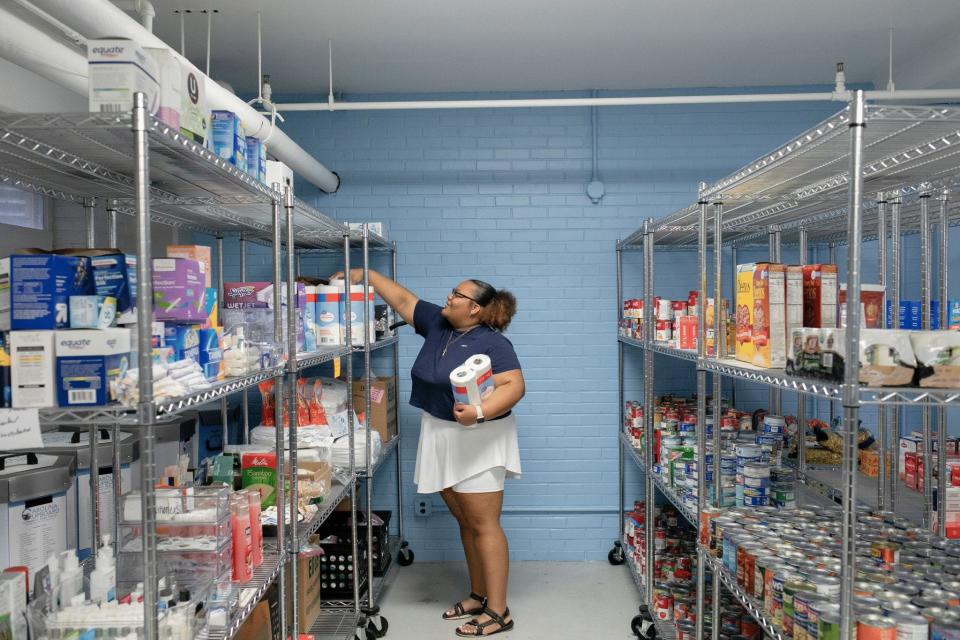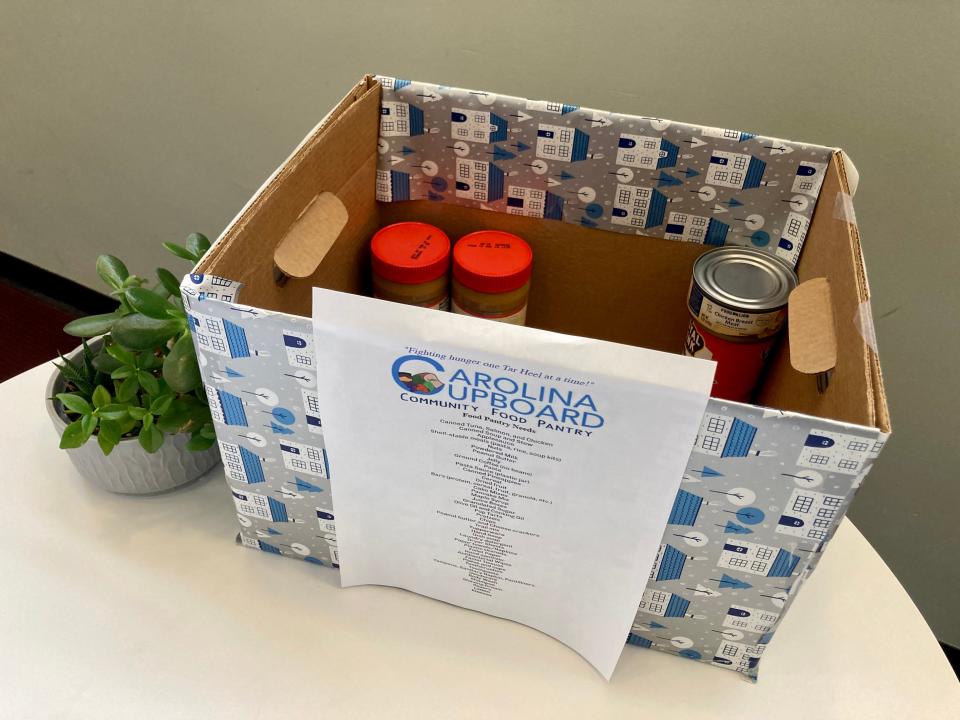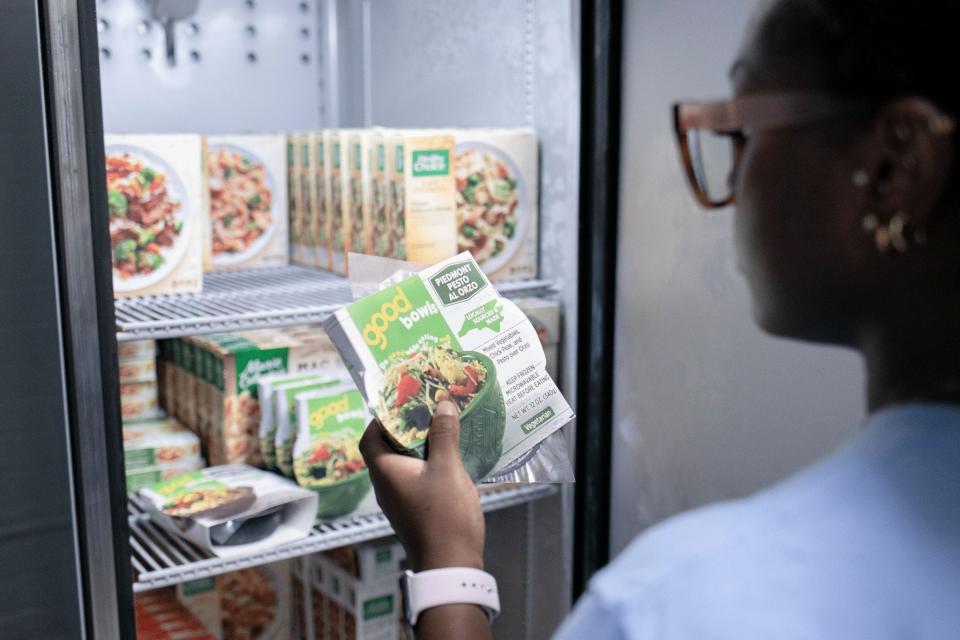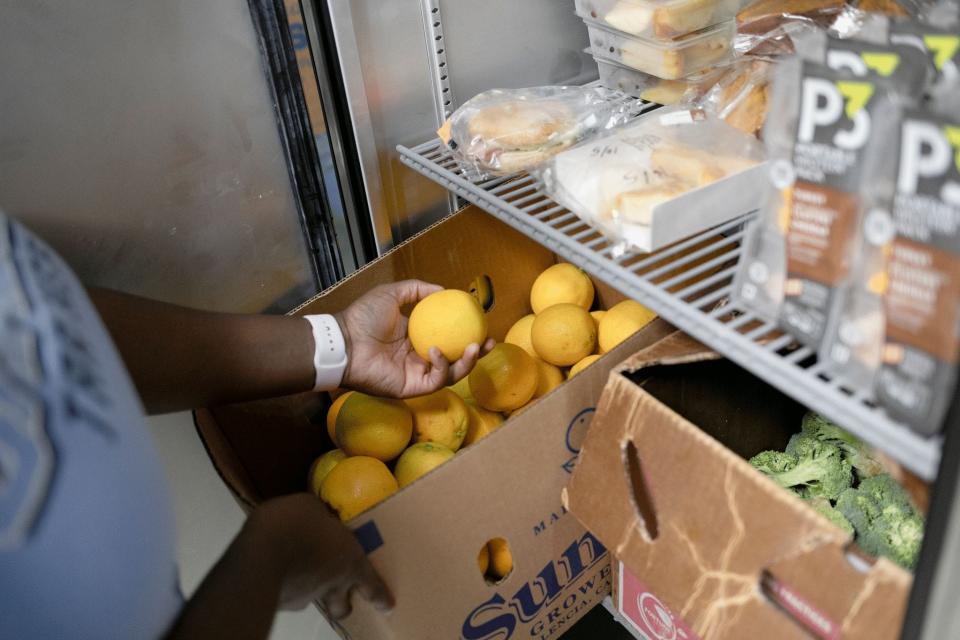What makes food insecurity worse? When everything else costs more too, Americans say
Despite signs inflation might be improving, a majority of Americans this fall felt the economy was making food insecurity worse for millions of low-income people in the U.S.
Last year, the number of Americans who said they didn't have enough to eat went up, as pandemic-era food assistance programs expired in many states. This November, researchers found a striking one-third of people in the U.S. experienced food insecurity at some point in their life.
Americans continue to say they're worried about the high cost of food and the unaffordability of other basic needs, like housing. This week's data, which was gathered from a nationally representative survey, is in line with what food banks leaders across the country heard from clients this fall: The high cost of everything from rent, to gas to health care is putting intense pressure on people's grocery budgets. After inflation, homelessness is the second greatest economic concern for people across the country, according to the survey, which was conducted on Nov. 7 and 8.
The report, which was commissioned by the meal-kit company HelloFresh, found nearly 3 in 4 people feel "the economy is creating a bigger crisis for food insecurity."
Financial uncertainty became "severe" for low-income people at the height of the COVID-19 pandemic, "and it just didn't go away," said Jeff Yorzyk, who runs food donation programs for HelloFresh. "It seems like it's getting worse, and it seems like folks are very concerned about the economy as it relates to food insecurity."
Researchers also found Americans ages 18-34 were twice as likely as those 55 and older to say they've known what it's like to not have enough to eat.

College students and young professionals are struggling to get out from under school debt and undergraduates are more likely to work the lowest paying jobs, because that's often the only work option their class schedules allow, college food pantry leaders across the country told USA TODAY. One of the easiest ways for thrifty college students to cut back on high-cost fees is to skip the campus meal plan entirely, advocates and researchers told USA TODAY.
"Food insecurity is way more prevalent than anyone would ever think or know," said Carlisle Watts, president of the student-run food pantry at the University of North Carolina at Chapel Hill, which served more than 250 students this semester.
Inflation is still stinging for low-income people
Even as inflation has slowed in some consumer categories this fall, grocery prices remain stubbornly high, putting the most pressure on people with very low incomes, who spend a greater percentage of their money on food.
Food prices this October were more than 3% higher than in October 2022, according to the U.S. Department of Agriculture.
In New Jersey, Julie Kinner says older people are relying more on her free food nonprofit Table to Table, "because their dollar doesn't stretch as far." During the pandemic, seniors got some of the biggest increases to their Supplemental Nutrition Assistance Program allotments, but after the federal emergency declaration ended, the demographic has seen some of the sharpest drop-offs in benefits.
"Consistently we hear how the decrease in SNAP after COVID hit them hard," Kinner said. "Imagine getting the same amount of money every month and watching the prices go up. Everybody uses the egg example, but it's like that across the board."

Young people face most food insecurity
More so than seniors, younger people are bearing the brunt of the hunger crisis, the authors of this week's report said.
Among people ages 18-34, more than 40% have experienced food insecurity and reported feeling concerned about hunger for themselves and their families because of the economy, according to the HelloFresh survey.
At the University of North Carolina at Chapel Hill, there are three food pantries on campus for undergraduates, graduate students and nursing students.
"The college-age students are a high-risk group," said Amanda Holliday, who runs the pantry for graduate students on campus. "You're pressed for time and resources, and you also are experiencing a change in your support structure. You're now on your own. Transportation changes, resources change," she said.
Besides food, the pantries at UNC all provide necessities like toilet paper, menstrual products, diapers and laundry detergent for anyone who needs them. Demand at CJ's Pantry, which Holliday runs, has only grown over the past three years, and it's become more important to provide access to culturally relevant food items for Asian and Latino students, she said.
She said her research found around 10% of students at the Gillings School of Global Public Health experience food insecurity.
"People think, 'Oh, those people, they have food − they're not food insecure,' and that's not the case," Holliday said, explaining that CJ's Food Pantry is named after her grandmothers, Celeste and Josephine, who she said were nutrition pioneers working to alleviate hunger in central and eastern North Carolina in the 1940s.

Demand is up at college food pantries
The turnover rate at CJ's Food Pantry has increased five-fold since it launched in 2020, according to Holliday.
"We put something on the shelf and it's gone in 12 hours," she said.
She said international students utilize the pantry at some of the highest rates, because they're not eligible for any federal college grants or food benefits.
In northern New Jersey, "We see more older teens and people in their younger 20s at the college pantries than we ever have before," said Kinner, whose nonprofit delivers food to pantries at Montclair State University, William Patterson University, Rutgers University and the New Jersey Institute of Technology.
She also said that this year, church food pantries she works with had to extend their hours to meet the needs of more people who have busy 9-5 work or school schedules.
At Colorado University in Boulder, college staff said they've seen students struggle to pay for food because work requirements tied to governments benefits prevented students from accessing SNAP, because they're not able to work the required number of hours per week in addition to attending classes.
"We see students regularly skipping meals, choosing to eat less, prioritizing housing costs over food costs and seeking resources that we haven't seen students seek quite as much in the past," said Hannah Wilks, who runs the university's Basic Needs Center. The Buff Pantry, located inside the center, serves around 350 student per week, Wilks said.
"We need to reset ourselves," Holliday said. "In K-12 education, we've accepted how important it is for young minds to have nutrition" she said, referring to free and reduced school lunch programs for kids from low-income families. "And that doesn't change at 18 − our brains are still growing. Wouldn't it be nice if every student had access to just one meal a day?"

Free food must also be nutritious, pantry leaders say
Food banks across the country reported getting less in financial donations from the public in 2023, which meant they couldn't buy as much food. Fresh vegetables are often one of the most expensive items for food nonprofits to procure and store properly, said Kinner, who added her nonprofit has seen donations dwindle by more than 50% this year.
“What people don’t realize is that food insecurity can be on a lot of different levels," Watts, 20, said. "Maybe you can buy almost all of your things but you can’t get everything. Or maybe you can get ramen but you can’t get nutritious, healthy food.”
Nutrition professors at UNC started making fresh meal bowls by hand in recent years to bolster the nutritional value of the items available at CJ's Food Pantry.
"Cheaper food is often less nutritious, it's often highly processed and sometimes high in salt and sugar," said Alice Ammerman, a nutrition professor who had the idea to make "Good Bowls" for food-insecure people at UNC. The bowls' ingredients are inspired by the health-conscious Mediterranean diet, which Ammerman skews to align with Southern home-cooking taste preferences, she said.
According to the USDA, one definition of food insecurity is when a household must resort to eating lower quality diets, with less variety.
In Newark, Table to Table receives hundreds of pallets of fresh food every week from the local HelloFresh distribution center, which is one of the company's largest in the country.
It's critical that food companies ensure their surplus fresh food goes to people in need in the communities they operate in, said Yorzyk, because the level of food insecurity is so great.
"Even a very small percent of our produce turns into a lot of pallets of food," he said, describing the heaps of fresh carrots, peppers and cucumbers HelloFresh gives to Table to Table. Each week, clients are most excited to get the fresh meal kits, said Kinner.

Fighting hunger means fighting stigma, advocates say
More churches in northern New Jersey are opening food pantries for the first time, said Kinner, who receives applications from community groups wanting to work with Table to Table. It's a clear indication that food insecurity is a growing issue, she said.
In Chapel Hill, student organizers try to make the Carolina Cupboard as safe and welcoming as possible, because stigma surrounding food insecurity is a very real barrier for students in need, Watts said.
“There’s no shame in asking for help, because it is such a widespread problem and not something within your control," she said.
When Tar Heels come to the pantry, located in a dorm building, they don't need to prove anything, like their level of need, Watts said, and they're allowed to go home with as much food as they can carry, no questions asked.
"We just want to be somewhere that’s quick and easy for them, because food shouldn’t be a barrier to doing any of the things you want to do, or following your dreams," she said.
This article originally appeared on USA TODAY: America's college-aged kids don't have enough to eat

